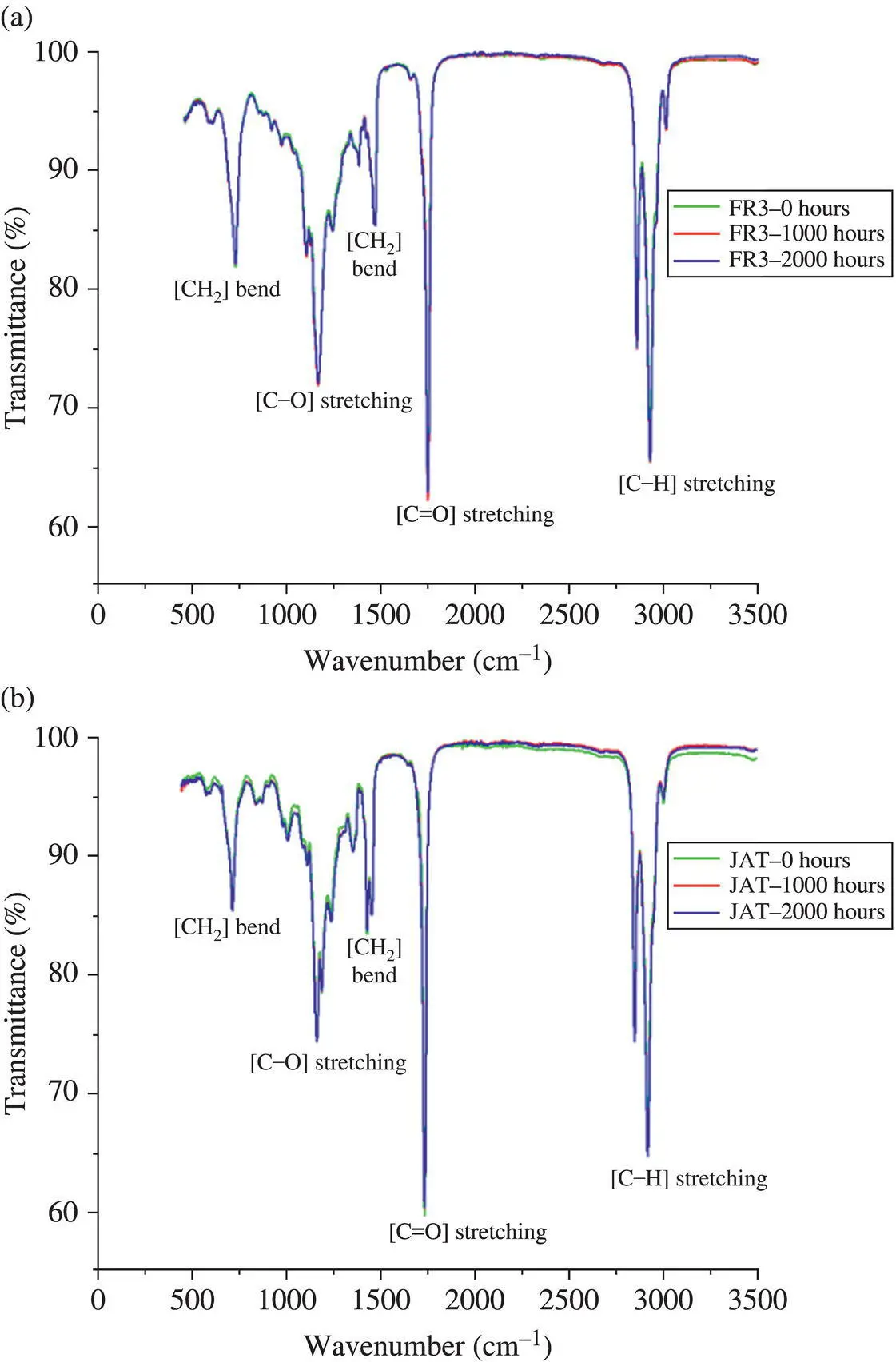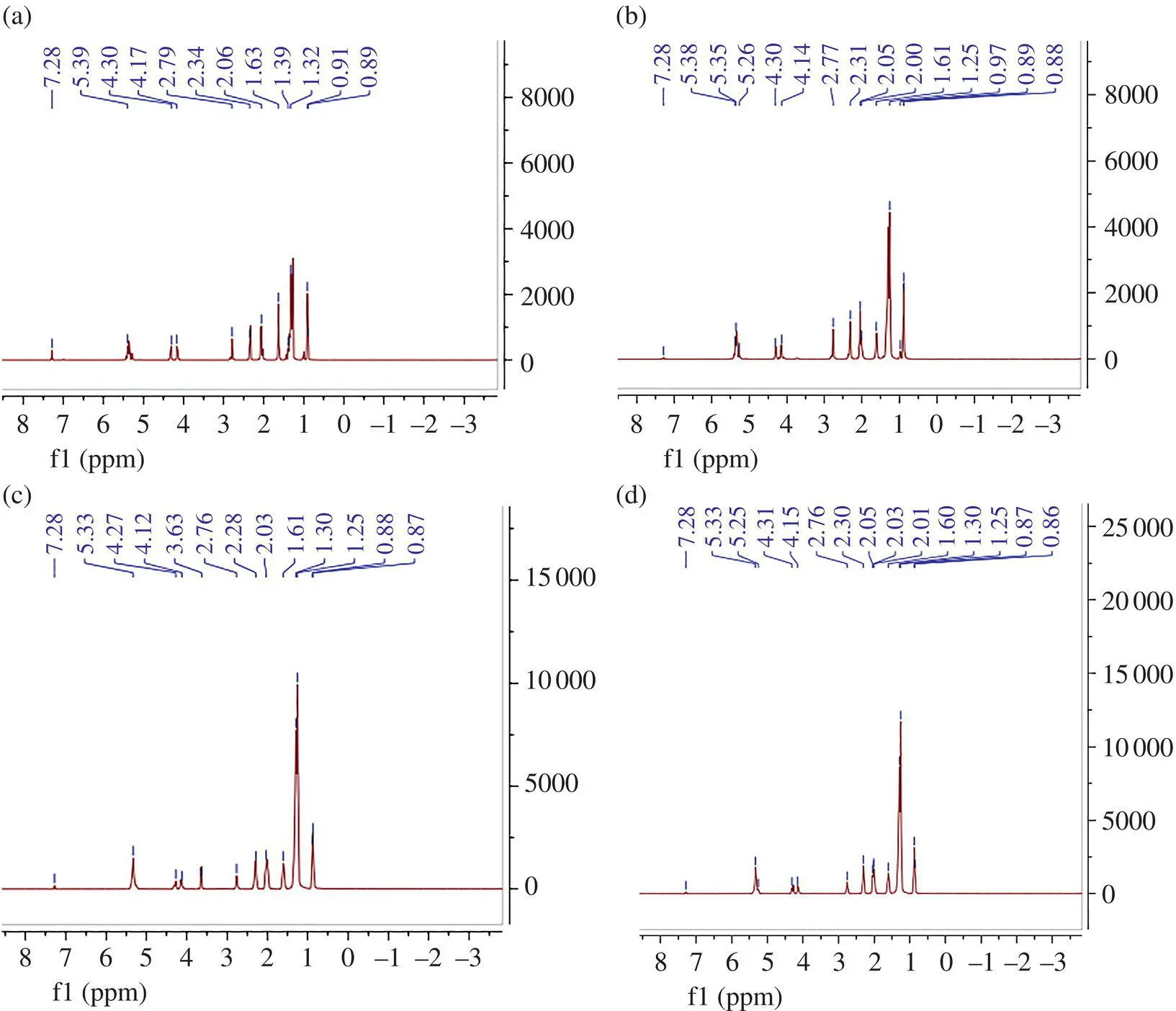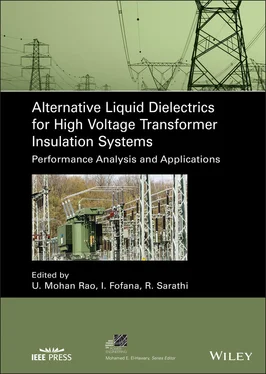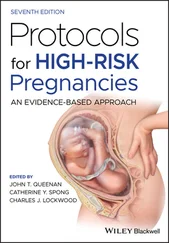As shown in Eqs. (2.10)– (2.13), triglyceride hydroperoxide is formed by the reaction of free radical, oxygen, and oil molecules [70, 71]. In the chain reaction, hydroperoxides break down to more free radicals. A variety of compounds like smaller oxygen‐containing by‐products such as alcohols, aldehydes, ketones, and high molecular acids are produced by decomposition of triglyceride hydroperoxides. In the termination reaction, stable high molecular compound ROOR is formed by combination of the peroxy radicals RO 2. At the last stage of oxidation, secondary nonvolatile substances of oxidation are subjected to polymerization which leads to the formation of high molecular weight gelatinous compounds, which tend to stick to the walls of the transformer or bottom of the aging vessels in laboratory experiments. Hydrolysis is another phenomenon which occurs simultaneously with the oxidation process in the natural esters. This is an autocatalytic reaction, because FFA molecules themselves accelerate the hydrolysis reaction. The steps involved in hydrolysis reaction, which are reversible in nature, are shown in Eqs. (2.14)– (2.16)[72]. The hydrolytic degradation mainly increases the acidic level of NEOs in due course of time. Temperature contributes to a large increase in the acidity of NEOs under high heat due to pronounced hydrolytic degradation.

Figure 2.9 (a) Aging test setup. (b) Oil samples depicting change of color due to aging.
For carrying out the aging experiment to understand the degradation of the oils, the single temperature technique in sealed beaker or an open beaker technique may be used simulating the transformer interior as per the relevant standards. During this process, thermal stress is applied on the composite system of the oil and the corresponding quantity of solid insulation, at a fixed temperature. The duration of thermal stress is changed and samples are collected after the set time intervals for performing the experiments. Complete drying of the solid insulation is carried out to make them moisture‐free. The maximum temperature to carry out the aging process of oils should be as per IEEE C57.147 and preferably kept below 180 °C to avoid fluid scorching. The oil dilatation must be taken into consideration while filling the vessels for aging of oil samples as they expand on application of heat. The coefficient of thermal expansion of natural esters is approximately 0.0007/°C, so there is a 1% increase in volume for every 14 °C rise in temperature, by using the expression,
(2.17) 
where Δ V is the change in volume, β is the thermal expansion coefficient, V is the initial volume, Δ t is the temperature difference.
A few studies to ascertain as to whether the structure of the functional groups has changed in the oil samples are given below.
2.5.1 Fourier Transform Infrared Spectroscopy (FTIR)
The Fourier Transform Infrared Spectroscopy (FTIR) analysis is performed to identify the existence of the diverse functional groups in the fresh and aged oil samples. This technique aids in analyzing the uniformity of the oil after degradation in other properties because of temperature and duration. In this process, the infrared (IR) radiation is passed through the oil, out of which some percentage is absorbed and some percentage is transmitted. There are different values of frequencies which indicate different functional groups and thus the resulting spectrum represents the molecular absorption and transmission, creating a molecular fingerprint of the sample. When the IR radiation is absorbed, the molecules of the oil vibrate and it leads to bending or stretching of the bonds. It is observed from studies that the transmittance of the a few natural esters like FR3 and Jatropha (JAT) remain unaffected after aging for 2000 hours at 150 °C [73]. As seen in Figure 2.10a and b, the existence of alkanes is denoted by peaks near to 3000 cm −1wavenumbers for C–H stretching. For both oils, the existence of esters is indicated by peaks near to 1740 cm −1for C=O stretching. The CH 2bending is witnessed at wavenumbers around 1460 cm −1for both the oil samples. The peaks at 1000–1260 cm −1for both oil samples for C–O stretching indicate the presence of alcohol. Aging in oil leads to the formation of carbonaceous particles. Nonetheless, the integrity of the oil is intact as all the functional groups are present even after long hours of aging. There is no significant difference observed for a particular oil in various aging times considered. Thus, the FTIR study might provide evidence if the aging is performed for a longer duration. The chemical structure of the oils is not affected but the performance of the oil degrades after aging, as the other thermophysical and electrical properties deteriorate.

Figure 2.10 FTIR spectrum of (a) FR3 aged at 1000 and 2000 hours along with fresh FR3 and (b) Jatropha aged at 1000 and 2000 hours along with fresh JAT.
Source: Baruah et al. [73] / with permission of IEEE.
2.5.2 Nuclear Magnetic Resonance (NMR) Study
The alteration of the chemical assembly of the oil can be studied using the nuclear magnetic resonance (NMR) study. In the NMR spectrum, multiplets are observed for CH 3, CH 2, and allylic protons of the fatty acid fragments in the section of 0.87–2.78 ppm, for both the oil samples, as seen in Figure 2.11. In the range of 4.12–5.35 ppm, two multiplets are identified meant for the CH 2and CH protons of the glycerol moiety. The existence of methyl ester group is established at 2.3 ppm. The peak that represents the chloroform solvent for both the oils is observed at 7.28 ppm, and this is considered the reference peak [74]. The NMR spectroscopy shows if there are any changes in the structure of the samples over a long duration. However, no significant difference is observed for the oil spectra of NEOs after accelerated aging hours.

Figure 2.11 NMR analysis of (a) new FR3, (b) aged FR3 for 2000 hours, (c) new JAT, and (d) aged JAT for 2000 hours.
Source: Baruah et al. [73] / with permission of IEEE.
2.6 Dissolved Gas Analysis in Natural Esters
Occurrence of faults in the electrical network is very much likely, but proper monitoring can help avert any catastrophic incidence. The two main categories of faults arising in the transformers are thermal and electrical. These faults lead to breakdown of insulation, and release gases in the interior of the transformer, which are detrimental to the overall functioning of the apparatus. Thus, it is very much important to measure the health of the transformer at fixed durations. DGA is an indispensable method to assess the condition of a transformer to gauge the severity of the incipient faults. The key gases developing in the transformer as a result of fault and aging are: (i) hydrogen and hydrocarbons – hydrogen (H 2), ethane (C 2H 6), methane (CH 4), ethylene (C 2H 4), acetylene (C 2H 2), (ii) Carbon oxides – carbon monoxide (CO) and carbon dioxide (CO 2), and (iii) propylene (C 3H 6) and propane (C 3H 8). The increase in temperature leads to the evolution of these gases and with progressing time, the concentration of these gases change. Detecting the individual concentration and applying the various standard methods can help identify the incipient faults that might occur inside the transformer.
Читать дальше
















